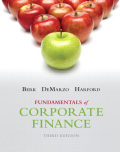
EBK FUNDAMENTALS OF CORPORATE FINANCE
3rd Edition
ISBN: 9780133762808
Author: Harford
Publisher: PEARSON CUSTOM PUB.(CONSIGNMENT)
expand_more
expand_more
format_list_bulleted
Concept explainers
Question
Chapter 11, Problem 1P
Summary Introduction
Realized Returns:
Realized returns refer to the actual returns that are earned during the holding period of an investment. Realized returns include dividends, interest payments, and cash distributions. It is acquired though the movement of prices of stocks from one period to another or from time to time. The movement in price reflects the changes that occur until the holding period of time of an investment. It carries the dividend amount with it. It can be measured in two ways, which are
To determine:
The realized return.
Expert Solution & Answer
Want to see the full answer?
Check out a sample textbook solution
Students have asked these similar questions
Need answer.
Solve plz now
Precious metal qn solve .
Chapter 11 Solutions
EBK FUNDAMENTALS OF CORPORATE FINANCE
Ch. 11 - Prob. 1CCCh. 11 - Why do investors demand a higher return when...Ch. 11 - For what purpose do we use the average and...Ch. 11 - How does the standard deviation of historical...Ch. 11 - What is the relation between risk and return for...Ch. 11 - Prob. 6CCCh. 11 - Prob. 7CCCh. 11 - Prob. 8CCCh. 11 - Prob. 9CCCh. 11 - Does systematic or unsystematic risk require a...
Ch. 11 - What does the historical relation between...Ch. 11 - What are the components of a stock's realized...Ch. 11 - What is the intuition behind using the average...Ch. 11 - Prob. 4CTCh. 11 - How does the relationship between the average...Ch. 11 - Consider two local banks. Bank A has 100 loans...Ch. 11 - What is meant by diversification and how does it...Ch. 11 - Which of the following risks of a stock are likely...Ch. 11 - Prob. 9CTCh. 11 - Prob. 10CTCh. 11 - If you randomly select 10 stocks for a portfolio...Ch. 11 - Why doesn't the risk premium of a stock depend on...Ch. 11 - Prob. 13CTCh. 11 - DATA CASE Today is April 30, 2016, and you have...Ch. 11 - Convert these prices to monthly returns as the...Ch. 11 - Prob. 3DCCh. 11 - Prob. 4DCCh. 11 - Prob. 5DCCh. 11 - What do you notice about the average of the...Ch. 11 - Prob. 1PCh. 11 - Prob. 2PCh. 11 - Prob. 3PCh. 11 - Your portfolio consists of 100 shares of CSH and...Ch. 11 - You have just purchased a share of stock for $20....Ch. 11 - The following table contains prices and dividends...Ch. 11 - Prob. 7PCh. 11 - Prob. 8PCh. 11 - Use the data in SBUX_GOOG.xlsx on MFL to answer...Ch. 11 - Download the spreadsheet from the book's Web the...Ch. 11 - Prob. 11PCh. 11 - Prob. 12PCh. 11 - Prob. 13PCh. 11 - Consider the following five monthly returns: a....Ch. 11 - Explain the difference between the arithmetic...Ch. 11 - Prob. 16PCh. 11 - Prob. 17PCh. 11 - Prob. 18PCh. 11 - Prob. 19PCh. 11 - Prob. 20PCh. 11 - Prob. 21PCh. 11 - You are a risk-averse investor who is considering...
Knowledge Booster
Learn more about
Need a deep-dive on the concept behind this application? Look no further. Learn more about this topic, finance and related others by exploring similar questions and additional content below.Similar questions
arrow_back_ios
SEE MORE QUESTIONS
arrow_forward_ios
Recommended textbooks for you
 Essentials Of InvestmentsFinanceISBN:9781260013924Author:Bodie, Zvi, Kane, Alex, MARCUS, Alan J.Publisher:Mcgraw-hill Education,
Essentials Of InvestmentsFinanceISBN:9781260013924Author:Bodie, Zvi, Kane, Alex, MARCUS, Alan J.Publisher:Mcgraw-hill Education,

 Foundations Of FinanceFinanceISBN:9780134897264Author:KEOWN, Arthur J., Martin, John D., PETTY, J. WilliamPublisher:Pearson,
Foundations Of FinanceFinanceISBN:9780134897264Author:KEOWN, Arthur J., Martin, John D., PETTY, J. WilliamPublisher:Pearson, Fundamentals of Financial Management (MindTap Cou...FinanceISBN:9781337395250Author:Eugene F. Brigham, Joel F. HoustonPublisher:Cengage Learning
Fundamentals of Financial Management (MindTap Cou...FinanceISBN:9781337395250Author:Eugene F. Brigham, Joel F. HoustonPublisher:Cengage Learning Corporate Finance (The Mcgraw-hill/Irwin Series i...FinanceISBN:9780077861759Author:Stephen A. Ross Franco Modigliani Professor of Financial Economics Professor, Randolph W Westerfield Robert R. Dockson Deans Chair in Bus. Admin., Jeffrey Jaffe, Bradford D Jordan ProfessorPublisher:McGraw-Hill Education
Corporate Finance (The Mcgraw-hill/Irwin Series i...FinanceISBN:9780077861759Author:Stephen A. Ross Franco Modigliani Professor of Financial Economics Professor, Randolph W Westerfield Robert R. Dockson Deans Chair in Bus. Admin., Jeffrey Jaffe, Bradford D Jordan ProfessorPublisher:McGraw-Hill Education

Essentials Of Investments
Finance
ISBN:9781260013924
Author:Bodie, Zvi, Kane, Alex, MARCUS, Alan J.
Publisher:Mcgraw-hill Education,



Foundations Of Finance
Finance
ISBN:9780134897264
Author:KEOWN, Arthur J., Martin, John D., PETTY, J. William
Publisher:Pearson,

Fundamentals of Financial Management (MindTap Cou...
Finance
ISBN:9781337395250
Author:Eugene F. Brigham, Joel F. Houston
Publisher:Cengage Learning

Corporate Finance (The Mcgraw-hill/Irwin Series i...
Finance
ISBN:9780077861759
Author:Stephen A. Ross Franco Modigliani Professor of Financial Economics Professor, Randolph W Westerfield Robert R. Dockson Deans Chair in Bus. Admin., Jeffrey Jaffe, Bradford D Jordan Professor
Publisher:McGraw-Hill Education